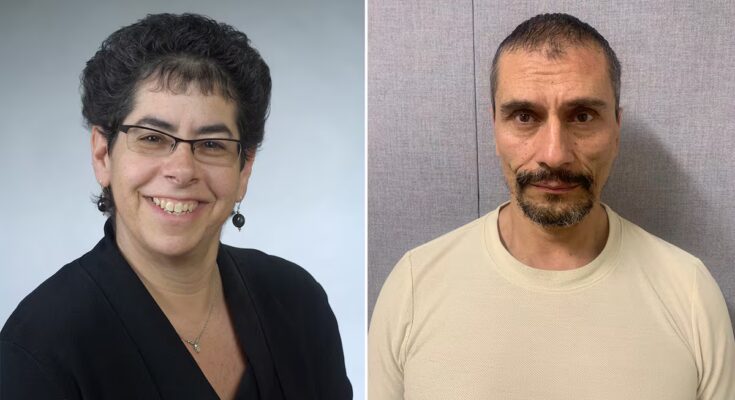Police arrived at the crime scene after receiving a 911 call on the morning of October 25, 2010. Sue Ann Marcum, a 52-year-old American University accounting professor, was found dead at the bottom of the stairs leading to the basement of her home in Bethesda, Maryland, just outside Washington, DC. This marked the beginning of a case that took 15 years to solve, until last October 30, when a jury in the United States found Jorge Rueda Landeros, a 56-year-old yoga instructor with whom the victim had a romantic and business relationship, guilty of the second-degree murder of Marcum.
At first everything suggested a robbery gone wrong. The victim appeared to struggle with his attacker and his body showed severe head trauma and signs of strangulation, according to the police report. But investigators had doubts because nearly all of Marcum’s valuables were still in the house, including a diamond necklace she was wearing when she was found. The only thing missing was Marcum’s old Jeep Cherokee, which was no longer parked outside the residence when officers arrived.
The vehicle was recovered approximately 12 hours later. Andrew Hamlin, then 18, had stolen it, lost control and crashed during a police chase. Hamlin’s DNA was found in the Jeep, but police found no trace of him inside the house. On April 12, 2011, the young man admitted to stealing the Jeep but claimed he knew nothing about the murder. The investigation seemed to have stopped six months after the crime.
The case took a turn that same month when authorities said the alleged trespass at Marcum’s home appeared to be a setup. Although they hadn’t made it public, agents had already uncovered a trail of documents pointing to Landeros as the prime suspect. The documents showed that the two had opened an investment fund together with the victim’s money and a $500,000 life insurance policy, in which Landeros was the sole beneficiary. Investigators also located traces of the yoga instructor’s DNA on the murder weapon, a bottle of tequila, at the crime scene and on the victim’s body. An arrest warrant for Landeros was issued in June 2011.
By then, the defendant had crossed the border and was living in Guadalajara, Mexico, where he had been hiding under a false identity for over a decade. Landeros introduced himself as León Ferrara, a former stockbroker who had given up everything to dedicate himself completely to yoga and poetry. He claimed to have no living relatives, spoke little about his past and survived on the bare minimum. According to acquaintances, he never seemed interested in money. In the United States, however, he was one of the FBI’s ten most wanted fugitives, a fact that was not revealed to the jury to avoid influencing the verdict.
Two versions of events clashed during the eight-day trial. The prosecution argued that the suspect abused Marcum’s trust for years to steal her money and that he killed her when he could no longer exploit their relationship for his own gain. Authorities presented several possible motives for the crime: that he killed her when he realized he could no longer extort money from her, that it stemmed from a fight over money, or that he wanted to collect on her life insurance policy.
“The defendant and Sue got into an argument. The fight started upstairs, on the main floor of the house,” prosecutor Debbie Feinstein told the jury. The sequence of events presented by authorities is that Marcum tried to escape and ran down the stairs, but tripped. According to this version, Landeros cornered her, hit her with a bottle and then strangled her. To cover up the murder, the defendant organized a robbery. In the end, the prosecution said, the defendant took the Jeep to escape and abandoned it in Washington, where it was found by Hamlin, the teenager who later admitted to stealing the vehicle.
In contrast, Meghan Brennan, Landeros’ attorney, argued that the authorities’ actions were deficient and that they had deliberately omitted evidence that did not fit their theory of what happened. In his arguments, he said his client was blamed because he was the “easiest” target and that Hamlin’s possible role in the crime should have been investigated more thoroughly.
“I’m innocent. I guess not of everything, but certainly of what they accuse me of,” Landeros said in a phone call to this newspaper a few days after his arrest in Mexico in December 2022. In that interview, he said the last time he saw Marcum was weeks before the murder and that authorities decontextualized the “everyday” problems he had with the victim to frame him. During the trial, Landeros chose not to testify and delegated his defense to his legal team.
The victim and Landeros met in 2005 and became friends a year later after he, a Mexican-American citizen, gave her Spanish and yoga lessons. During the trial, it was detailed how they grew closer over time, to the point that he became Marcum’s confidant and romantic partner, and even moved into her house and gave lessons there.
“She would have done anything for him,” Feinstein said at a news conference. The prosecutor said Marcum mortgaged his house and entrusted all his savings to Landeros, while he did not contribute a single dollar and used the money as he pleased to cover his own expenses. Authorities said in a news release that Marcum lost $312,000 during the two years they invested together, while Landeros made more than $250,000 at his expense.
Marcum taught at the business school for 11 years. Her students, friends and family remember her as talented, helpful and deeply devoted to others. “She was probably the best professor we had,” Don Williamson, the victim’s former colleague at American University, says in a video call.
A tax expert, Williamson says he met both men in early 2008 after Marcum asked for his help because they were having tax problems over a series of transactions that Landeros had not declared. “Whatever you do, don’t give this man money,” he advised his friend when they were alone.
The prosecution presented several emails in which the victim confessed her distress and had disagreements with Landeros regarding the management of her assets. A letter from the U.S. Internal Revenue Service was also presented, informing Marcum that he owed $15 million in taxes and penalties. “The person who appears to others to be the most successful may be the same person who, behind closed doors, suffers financial exploitation and physical abuse,” Feinstein told reporters.
Jorge Bátiz, a friend of the defendant, says by phone that the last time he spoke to Landeros was when he called him before he was extradited to the United States in 2023. “He told me, ‘I made a mistake, but I didn’t commit a murder.'” He also recalls that Landeros never told him about Marcum during the five years they were friends. Bátiz confesses that he feels disappointed, but also that he still cannot believe that the person he thought he knew was capable of such a crime. “I know León Ferrara, but I have no idea who Jorge Rueda Landeros is,” he says.
“At one point I thought they would never catch this guy, so I was so surprised when they arrested him in 2022,” Williamson admits. Landeros was arrested in a joint Mexican-US operation, without resistance, at the age of 52, the same age Marcum was when she was murdered. Prosecutors in Montgomery County, Maryland, benefited from the extensive media coverage the case received, especially in the United States. Someone who saw a documentary on television recognized the fugitive and alerted the authorities. On the other side of the border, however, the arrest went virtually unnoticed.
After deliberating for eight hours, the jury unanimously found Landeros guilty of the crime, but did not convict him of first-degree murder, finding insufficient evidence to prove premeditation. The defendant remained impassive when the sentence was read, according to journalists present in the courtroom. Sentencing is scheduled for February 6 and the maximum sentence is 30 years.
“It’s been 15 years,” Alan Marcum, Sue Ann’s brother, said emotionally at the press conference following the trial. Despite the sense that justice has finally been served, many people in Marcum’s circle still believe the damage is irreparable. “Sue Marcum is gone forever, and that can’t be undone,” Williamson lamented.
Sign up to our weekly newsletter to get more English-language news coverage from EL PAÍS USA Edition



